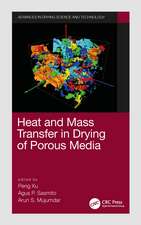Structure Property Correlations for Nanoporous Materials
Autor Abhijit Chatterjeeen Limba Engleză Hardback – 17 mai 2010
Explores simulation methodologies
Next, the book moves on to molecular modeling, placing a heavy focus on Monte Carlo simulation. It examines density functional theory (DFT) and local reactivity descriptors. It also discusses the synthesis of nanoporous materials, the structural characterization of materials in terms of chemical composition, spectroscopic analysis, mechanical stability, and porosity; and the design of new nanoporous materials. Dr. Chatterjee explores projected applications and concludes with a discussion of the catalytic activity of nanoporous materials and reaction mechanisms.
The text is supplemented with experiments and simulation instructions to clarify the theoretical analysis. Conveying the significance of the combination of traditional experimental work and molecular simulation, the book enables experimentalists to achieve better results with less effort.
| Toate formatele și edițiile | Preț | Express |
|---|---|---|
| Paperback (1) | 428.68 lei 6-8 săpt. | |
| CRC Press – 22 mai 2017 | 428.68 lei 6-8 săpt. | |
| Hardback (1) | 1101.87 lei 6-8 săpt. | |
| CRC Press – 17 mai 2010 | 1101.87 lei 6-8 săpt. |
Preț: 1101.87 lei
Preț vechi: 1557.10 lei
-29% Nou
Puncte Express: 1653
Preț estimativ în valută:
210.84€ • 220.13$ • 174.50£
210.84€ • 220.13$ • 174.50£
Carte tipărită la comandă
Livrare economică 04-18 aprilie
Preluare comenzi: 021 569.72.76
Specificații
ISBN-13: 9781420082746
ISBN-10: 1420082744
Pagini: 354
Ilustrații: 97 b/w images, 32 tables and approx 172 equations
Dimensiuni: 156 x 234 x 24 mm
Greutate: 0.66 kg
Ediția:New.
Editura: CRC Press
Colecția CRC Press
ISBN-10: 1420082744
Pagini: 354
Ilustrații: 97 b/w images, 32 tables and approx 172 equations
Dimensiuni: 156 x 234 x 24 mm
Greutate: 0.66 kg
Ediția:New.
Editura: CRC Press
Colecția CRC Press
Public țintă
ProfessionalCuprins
Basic Aspects of Nanoporous Materials. Molecular Modeling. Density Functional Theory. Local Reactivity Descriptors. Synthesis of Nanoporous Material. Characterization of Nanoporous Materials. Surface Activity Measurement. Application of Nanoporous Material. Catalytic Reaction. Appendix. Index.
Notă biografică
Abhijit Chatterjee received his Ph. D. from Burdwan University in West Bengal, India. He has travelled around the world and collaborated with many groups in catalysis before settling in Japan as a researcher in the field of computational chemistry. His research interest is focused on density functional theory and its application on different materials especially related to catalysis (zeolite, clay, and oxides).
Descriere
This book guides experimentalists in their design of nanoporous material using computer simulation methodologies. The book explores molecular modeling, placing a heavy focus on simpler methods such as Monte Carlo simulation and proposing easier technology for the bench chemist. It examines density functional theory (DFT) and local reactivity descriptors. It also discusses the synthesis of nanoporous materials, the structural characterization of materials, and the design of nanoporous materials. Dr. Chatterjee explores projected applications and concludes with a discussion of the catalytic activity of the nanoporous material and the reaction mechanism.

























